Interesting and informative: guided landing at the PTK NP
- Tutorial

The next stage is a large and, I hope, an interesting series of training posts on flights in Orbiter. After we successfully docked with the ISS in the previous post, the obvious next task is to go back to Earth, making an exact landing with acceptable overloads.
This post has a goal:
- Tell about the ship PTK NP.
- Give an idea of the physics of braking and landing maneuvers.
- Introduce a simple guide for a precise fit in Orbiter.
Previous Posts
This Orbiter post series starts with the idea of incrementally increasing complexity. Before flying under this instruction, I recommend that you familiarize yourself with the previous posts:
Cosmonautics History . Observation of flights without active participation.
"Breeze-M" . Basic maneuvers, access to the GSO.
Flight to the ISS . Maneuvers for rapprochement and docking.
A bit of history and theory
The big "broads" of the Chelyabinsk meteorite very clearly shows what happens with an unprepared space body entering the atmosphere at high speed. Movement in the atmosphere causes friction, which in turn leads to heating. If the apparatus entering the atmosphere is not protected by special engineering solutions, it will collapse.
Historically, the return of vehicles from orbit has been associated with manned flights and photo reconnaissance satellites (the captured film was returning). The first object returned from orbit was the empty capsule for the film (the technology was developed) of the Discovery-13, which landed on August 10, 1960. On August 18, the Discovery-14 capsule with the captured film returned:

on August 19, Belka and Strelka landed:
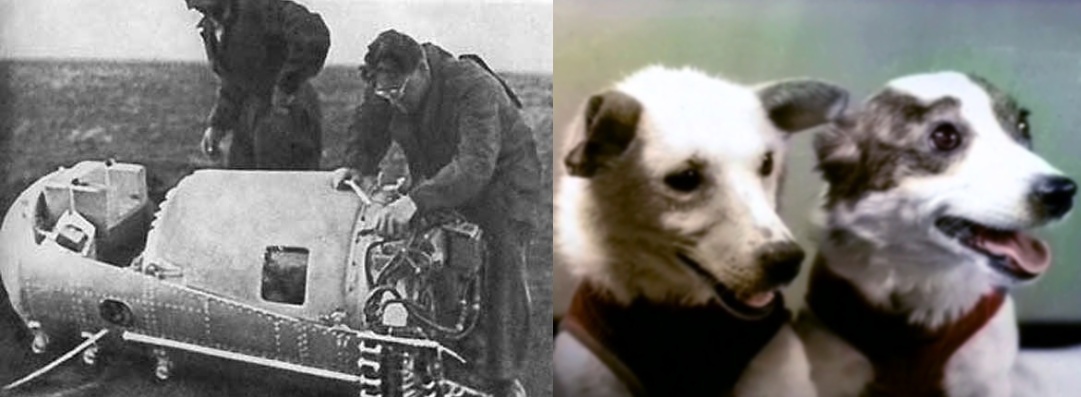
Braking in space
The first task that needs to be solved is the determination of the time for issuing a brake pulse. The earth rotates around its axis, and the landing site rotates with it. The satellite rotates in its orbit, the plane of which is usually inclined relative to the axis of rotation of the Earth:

If you draw a satellite’s line of motion above the Earth on the map, you will get sinusoids that move left on the map over time due to the rotation of the Earth:
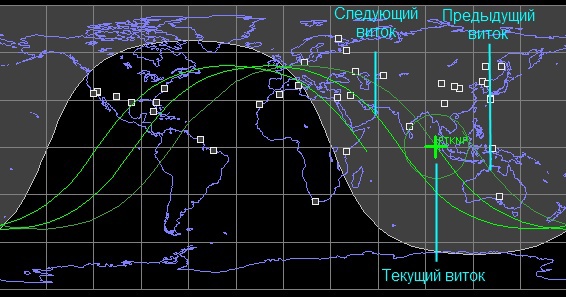
Therefore, if we want to land landing area, this can be done far from every turn. But, knowing the orbit of the ship, we can predict when the landing site will be in the plane of the orbit.
The second task is to give the required brake pulse. Every real spacecraft has a valid range of angles of entry into the atmosphere. If the angle is too large, then the density of the atmosphere will increase too quickly, and this will cause unacceptable overloads or an unacceptable thermal load on thermal protection. If the angle is too small, the atmosphere will not be able to "capture" the device, and it will fly back into space.
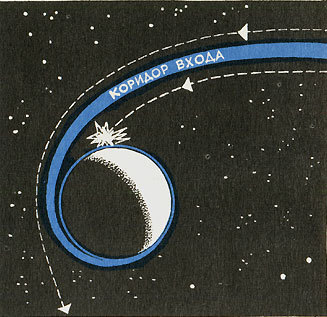
Atmospheric braking
The third task is to survive inhibition in the atmosphere. For this, the devices are equipped with special thermal protection. Ablative thermal protection is made of many layers of asbestotextolite impregnated with a coating of phenol-formaldehyde resins. It slowly burns down, like a book, in layers, losing with the burnt layer the temperature brought from without. Such thermal protection is disposable, it has been used since the beginning of the space program, it is widely used now. The second option is composite materials and ceramics, from which reusable tiles covering the apparatus are made. Space Shuttle and Buran used this option.
The fourth task is the descent control. Initially, the descent was uncontrollable. The Soviet apparatuses were round; they automatically orientated themselves in the stream like a roly-vodka and descended along a ballistic trajectory. Such a scheme is very reliable; it is still used in the scientific and biological satellites Photon and Bion. American vehicles used shunting engines and a spin to maintain the flight mode with a heat shield forward. Ballistic descent has serious drawbacks - overload reaches 9 g when returning from a circular orbit, 12 g when returning from the moon, and the landing area is measured in hundreds or even thousands of square kilometers. Therefore, the developers of space technology began to develop spacecraft with a controlled landing - Apollo and Soyuz. The idea implemented in them is the same.
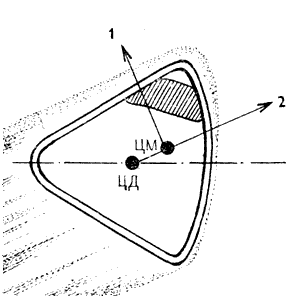
This lifting force is spent on the following actions:
- Slowing down the apparatus, which stretches the braking, reducing overload.
- Descent control, which allows you to land more accurately.
With a controlled descent at Soyuz and Apollon, the overload reaches 3-4 g, and the deviation from the aiming point is usually several kilometers.
Landing
The fifth challenge is a soft landing. In the United States, all ships except the shuttles landed. Water is “softer" than the earth when landing at low speed, and the large US fleet made it possible to quickly and efficiently bring splashed vehicles aboard. In the USSR, on Vostok ships, the astronaut catapulted at an altitude of several kilometers, so that, instead of hitting the ground in the spacecraft, it would absorb the kick. Sunrises and Unions used a parachute-jet system: a parachute gives a steady low speed of descent, and just before touching the ground, jet engines reduce it, ideally, to zero.
PTK NP
The Perspective Manned Transport System (PPTS), which is being developed now, is also known as the New Generated Manned Transport Vehicle (PTK NP), a ship with a long and interesting history. And it is necessary to tell and explain why it is needed, and why it uses the selected technical solutions.
Why is it needed?
This is not an idle question. The fact is that the Soyuz spacecraft was originally created for flights to the Moon and, theoretically, can cope with the tasks that are set for the PTK NP. For already fifty years of operation, the Soyuz has gained a reputation as a sort of space Gazelle - not a very comfortable, cramped, but hardy and reliable ship. Why change it to something new? However, there are such reasons. Despite all its advantages, Soyuz has shortcomings that cannot be corrected by modernization:
- Economy. Disposable and fully reusable ships were not very successful extremes. A partially reusable ship, in which only consumables such as a heat shield are replaced, should be cheaper and easier to operate. “Soyuz” cannot be made partially reusable - a blow to the ground during landing violates the guarantee on the strength of the hull. It is possible (and so it is) to remove components from a flying ship and put it on a new one, but, since this is not provided for by the design, it is not very effective.
- Large size landing zones. Now the landing zone of the "Union" has already become perceived as large. The maneuvering capabilities during the descent are limited by the design of the descent vehicle - a high “headlight” cannot reach large angles of attack. An exact landing is not compatible with the opening of parachutes at an altitude of 10 km - in a few minutes of descent, the wind can carry the ship over a long distance.
- Ballistic descent. The ballistic descent mode requires the reservation of a separate landing area: the first area for a controlled landing, the second - in case of failure in a ballistic descent. An overload of 9 g will not appeal to space tourists, and when they return from the moon, an overload of 12 g already becomes hazardous to health. Worse, a breakdown in ballistic descent upon returning from the moon at Soyuz means an emergency splashdown in the Indian Ocean, which is now worthless.
- Tightness. The Union is a fairly close ship. Of course, astronauts are not accustomed to overcoming the hardships and hardships of space flight, but why not remove them, if possible? And if we are going to carry space tourists, then it is better to load them more, and provide them with acceptable conditions.
- Low return weight. The Soyuz lander can return only 50 kg of cargo along with the crew, which is inconvenient.
- A small margin of characteristic speed. If we are going to fly to the Moon, then we want to have a larger reserve of characteristic speed (delta-V) than now. The Soviet lunar program was extremely, at the level of risk of flight safety, limited in fuel reserves due to the insufficient carrying capacity of the N-1 rocket, and a simple increase in the instrument-and-auxiliary compartment of the Soyuz was impossible without, in fact, creating a new ship.
- Media restrictions. The Soyuz spacecraft is firmly tied to the Soyuz launch vehicle, which now displays it without a reserve to increase its carrying capacity. To transfer a ship to Proton, as was done in the 60s for the lunar program, is theoretically possible, but extremely irrational, because Proton is gradually leaving the stage due to its shortcomings.
Goodbye wings
One of the notable technical decisions that were made at the PTK NP was the rejection of the wings (compare with the Clipper and the MAX ). PTK NP is a capsule slightly similar to the American Apollo. The fact is that wings are incompatible with universality. They help to make an exact landing, but this benefit is not comparable with the losses that occur if you disperse a mass of wings and aerodynamic surfaces that are useless in space to the Moon, the base at the Lagrange point, asteroids or Mars.
Special fit
The second notable technical solution was the landing system of the PTK NP. Initially, it was conceived as completely reactive, because such a scheme gives the greatest accuracy of landing. However, a fully rocket landing raises security concerns, so the parachutes returned. In its current form, the landing system consists of the following steps:
- At an altitude of several kilometers, a heat shield (as in the Union) is dropped.
- Three parachutes open at an altitude of 1.5 km. Since three domes are used, a reserve parachute is not needed (failure of one dome gives a permissible increase in the rate of descent).

- Deployment shock absorbing bearings are revealed.
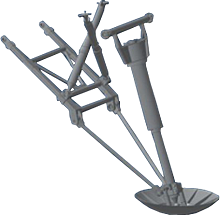
- Immediately before touching the ground, a complex reactive landing system is triggered. It fights off lateral drift by the wind (if any) to lower the capsule vertically and reduces the rate of descent to a soft touch.
- The energy of touching the ground is amortized by the landing supports and shock-absorbing seats of the crew (as a precaution).
Such a landing pattern is expected to ensure that it falls into a 5x5 km square with a standard landing.
Development history
It all started, probably, with the idea of ACTS - a joint ship with ESA for flights to the moon, approximately in the middle of the zero. Apparently, it was originally planned that the modified Soyuz with the Fregat booster block and the joint Russian-European equipment:
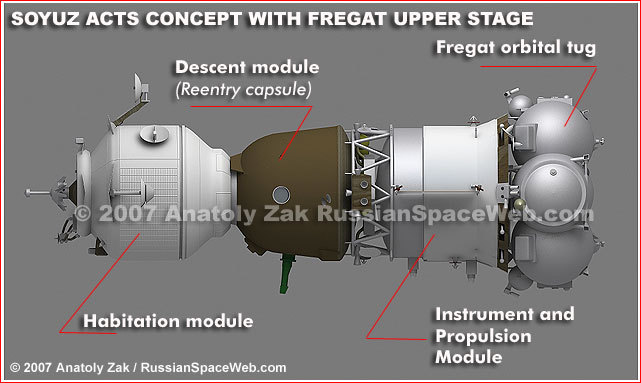
By the end of the zero years, the idea of a joint ship with ESA died, the ship began to be developed as soon as the Russian one, and, instead of the Soyuz modification, began Created from scratch. The
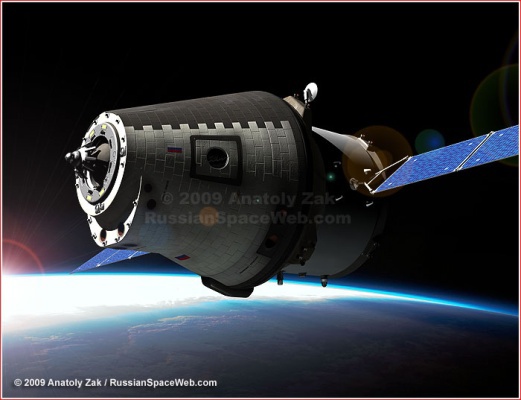
launch vehicle with an influx of shunting engines on the side became characteristic of the end of the zero: With the beginning of the tenth years, the influx disappeared:
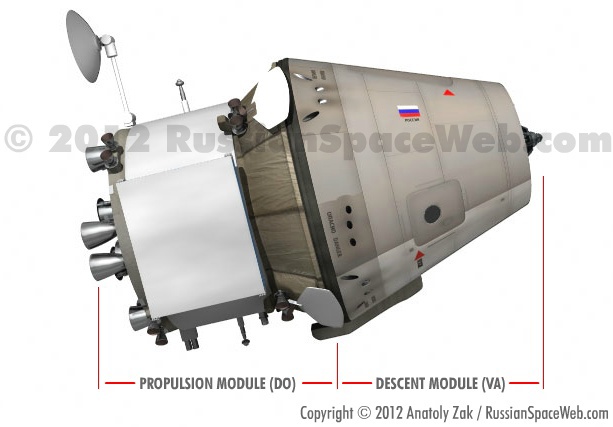
It was this model that was implemented in Orbiter. It is already outdated and not very realistic (why 8 marching engines?).
The most recent appearance of the ship in public is MAKS 2013:
The work is very active, the TV of Roscosmos regularly talks about them. The last clip is the Cosmonautics program, shown last Saturday:
News sources
You can track the progress of the PTK NP by:
- Profile topic on the forum "Cosmonautics News"
- TV channel Roscosmos
- The blog of test cosmonaut Mark Serov , who works at RSC Energia on the subject of PTK NP.
Flight preparation
For this flight we need:
- Orbiter itself , if you haven’t downloaded it yet
- Addon PTK NP
- Addon Aerobrake MFD
Flight plan
This flight can be divided into the following stages:
- Alignment of the plane of the orbit with the landing site.
- Braking to leave orbit.
- Guided braking in the atmosphere.
- Landing.
Stage 1. Alignment of the orbital plane with the landing site
Download the script. I chose the flight saved in the last post, so it seemed more interesting to me, you can use your save or load the PTK NP script - Docked to ISS :
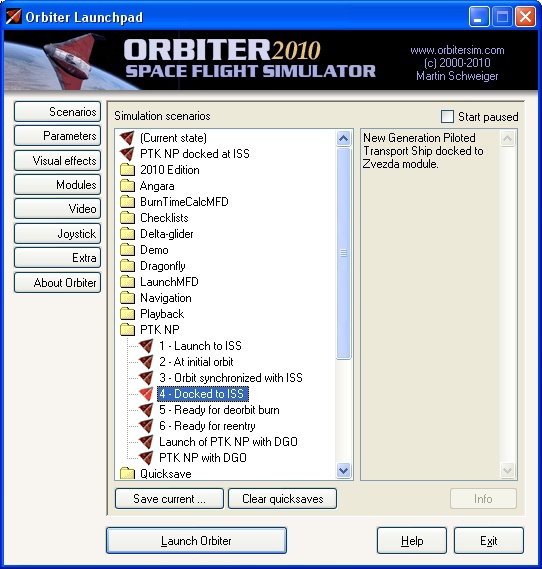
So, we are docked to the ISS.

We want to return to the Vostochny spaceport, so in the MFD map we select it as the target ( right Shift - T , Spaceports - Vostochny ). Also, put the left MFD into Aerobrake mode ( left Shift - F1 , left Shift - E , target selection left Shift-T , type Vostochny in the window that appears). Speeding up time, we will wait until we fly over the Vostochny at the next round. Docking from the ISS by Ctrl-Dand give a little momentum for the discrepancy:

Goodbye, ISS!
Stage 2. Braking for descent from orbit
After the divergence from the ISS, we wait until 18,000 km remains to Vostochny, we orient the spacecraft forward to slow down and give an impulse to leave orbit at the time when 17,000 km remain to Vostochny.

We slow down until the MFD Aerobrake shows a shortage of 1000 km:
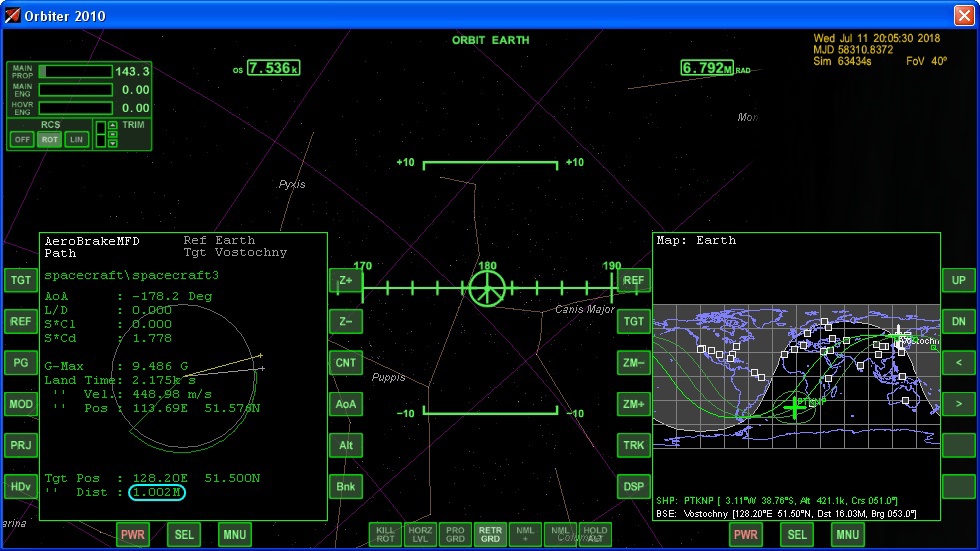
We need a shortage for disposal of aerodynamic quality.
Stage 3. Controlled braking in the atmosphere
Before entering the atmosphere, it is still necessary to separate the compartments. We orient the ship in a position against the orbital velocity vector (stern forward) and with zero roll. There is a good automatic attitude control mode "on the level of the horizon» - of L :
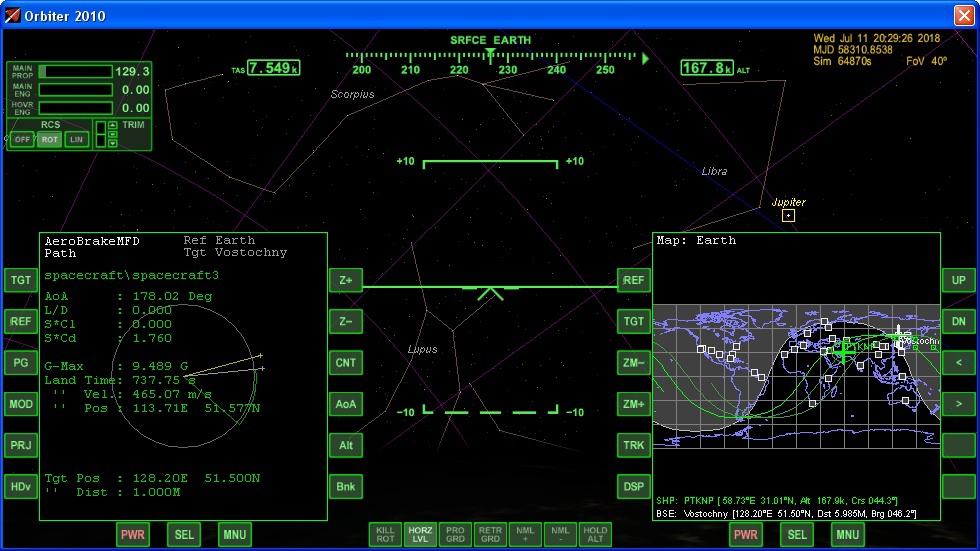
Let's wait a height of 150 km and a shooting cable-mast pressing the K , cast off the instrument-service module by pressing J . Unfortunately, after separation of the compartments, the MFD parameters will be reset. Choose East again as the target on the Aerobrake MFD. Pay attention to the change in shortage - MFD, unfortunately, considers only real data, without a forecast. Pressing the PRJ and PG buttons will put it into map mode. We translate the right MFD into atmospheric flight mode (right Shift - F1 , right Shift - S ). The result in the picture: The
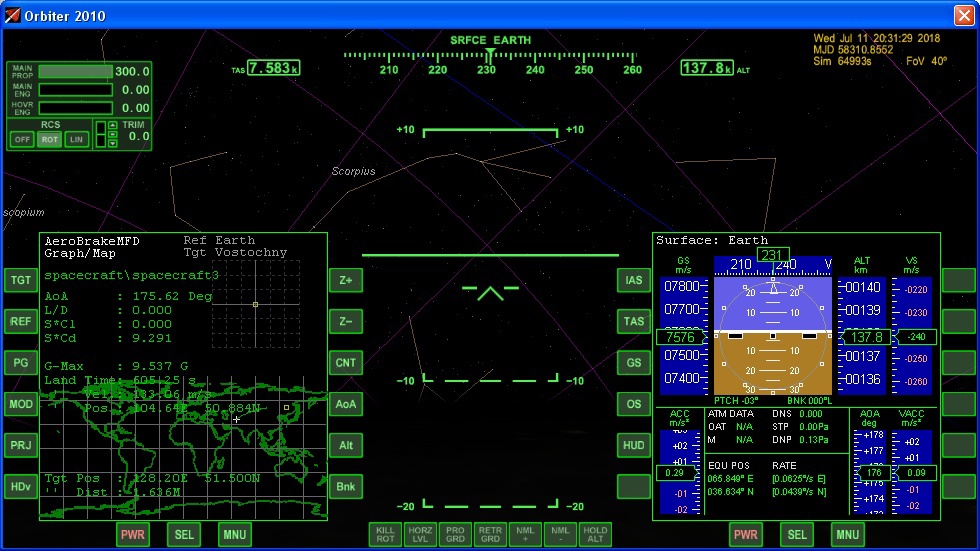
two of our control methods will be a trimmer and a roll. The trimmer is set with the Ins and Del buttons of the block above the cursor keys and simulates the center of mass position:
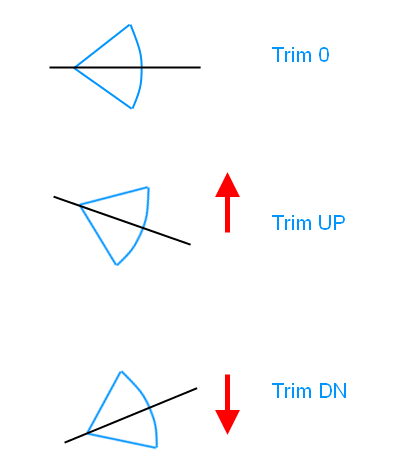
In reality, this angle is fixed, but here, fortunately, we can change it, this adds flexibility.
By changing the angle of heel, we can create a lateral component of the lifting force for displacement to the north or south. If the apparatus was more maneuverable, it would be possible to spend excess energy moving in a “snake”, but I did not succeed.
At an altitude of 130 km, where the first traces of the atmosphere appear, set the pitch angle to 10 degrees and set the trimmer to the maximum up.

At 100 km it's time to turn on the music
In the process of decreasing with the beginning of exposure to the atmosphere, the capsule will be set to a pitch angle of about 12 degrees. There may be fluctuations, but do not allow a strong swing, counter it with the KILLROT mode ( Num 5 ).
Height is 65 km, pay attention to the reduction of underflight on the left MFD and an indication of the noticeable lift on the right MFD:
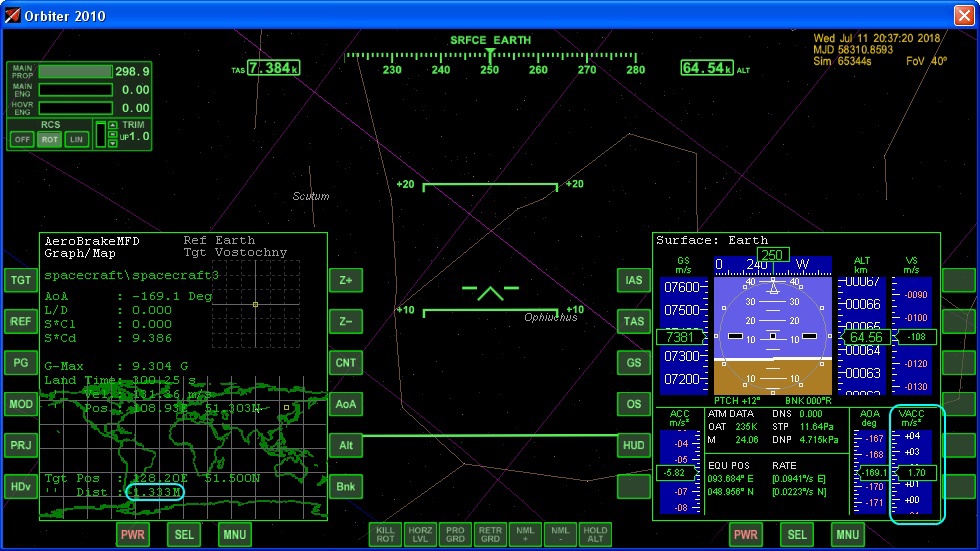
Height is 61 km. The capsule has already lost one kilometer per second and goes into climb due to lift:
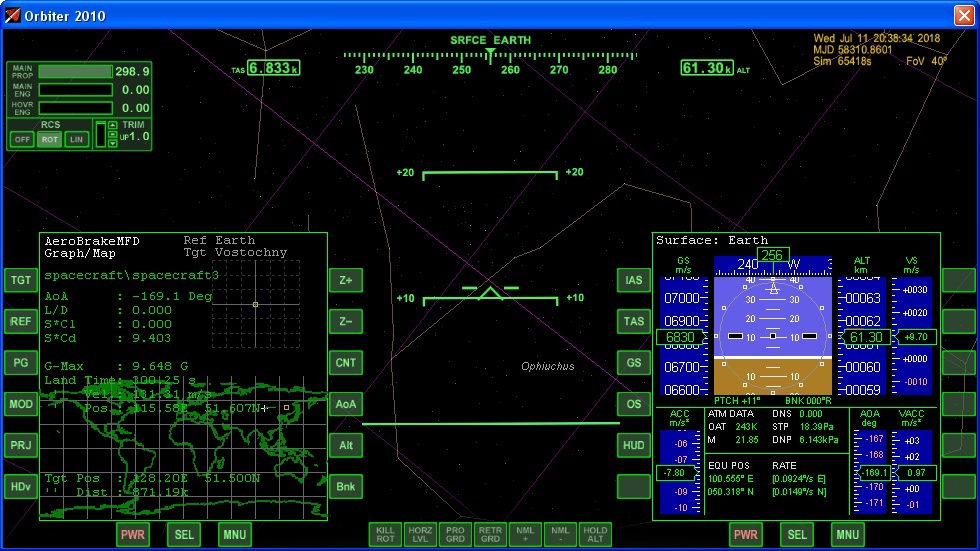
Altitude 50 km. On the left MFD, the track of our flight appears from above:

Judging by the track, we will go a little south. In order to shift to the north, we need to tilt the ship to the right. In this case, the lifting force will receive a lateral component deflecting us to the north. It is necessary to maintain a balance between maintaining the lifting force and lateral displacement, so as not to sit with a shortage.
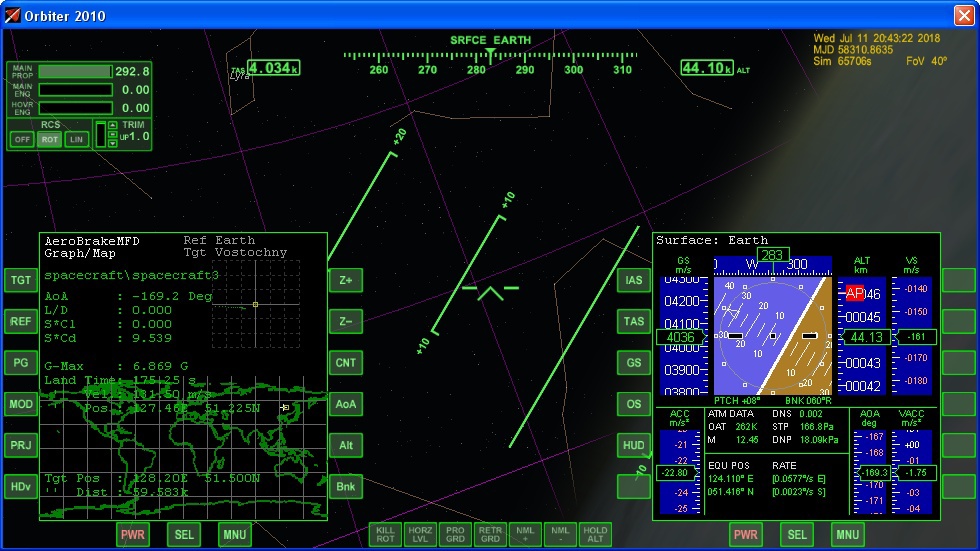
At an altitude below 40 km, we return the ship to a more vertical position - the speed drops, the lifting force drops. Pay attention to the overload - 3.3 G - is quite comfortable, and it is already reduced. Such an overload can also be experienced in public transport.

Below 15 km we reset the trimmer, it will not help us anymore. Error 12 km, sorry, more than I would like.
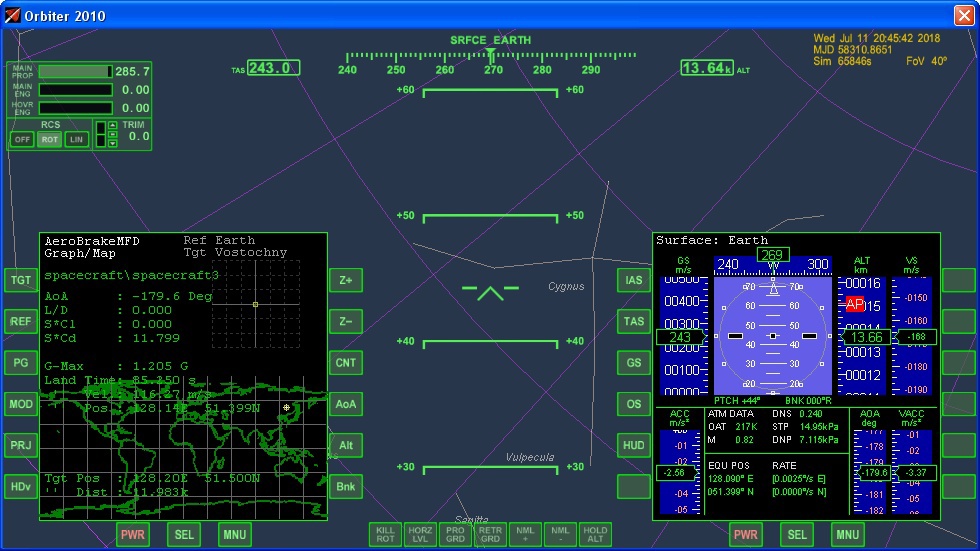
Landing
At a height of not less than 5 km reset parachute hatch cover pressing J . At a height of not less than 3 km run parachutes by pressing the disclosure procedure of the K . At an altitude of 1 km reset the heat shield by pressing J and disclose landing support by pressing the G . We are going to land:

At a height of 30 m we turn on the brake engines (in the usual way - press Num + and fix the activation with the Ctrl button )
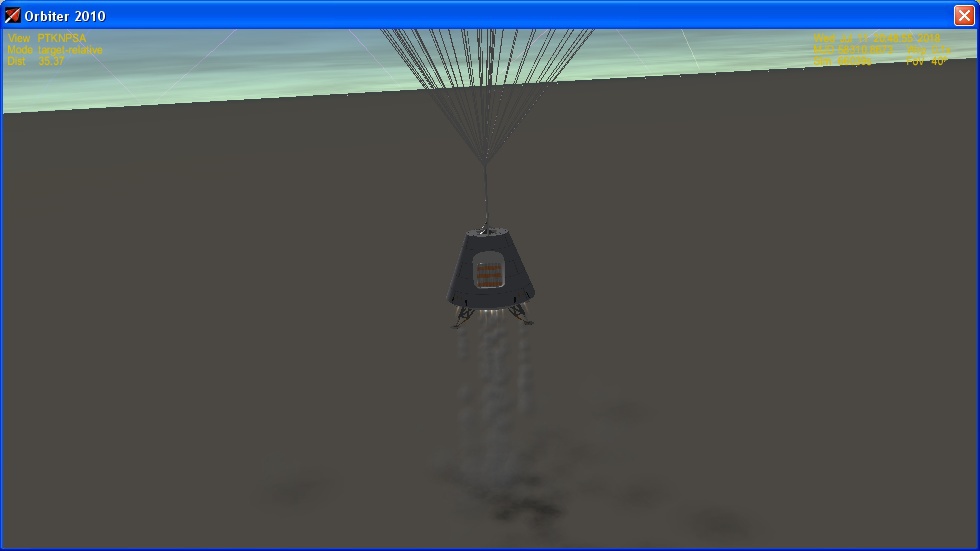
By touching the ground (if you have time), turn off the engines. Fold the parachutes ( left Shift - Num 1 ) and open the hatch ( left Shift - Num 2 ). Have a landing!
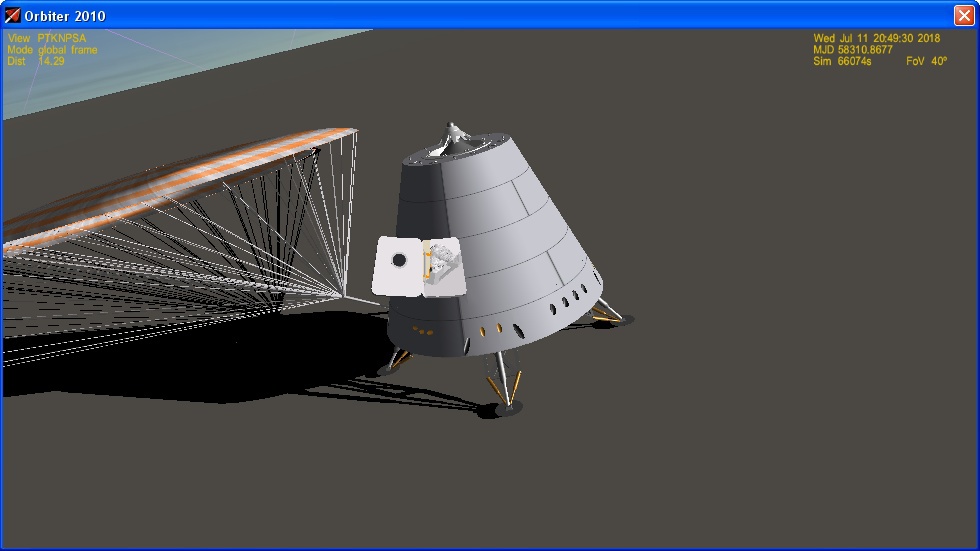
Conclusion
The specificity of the controlled landing is that you have to act quickly, and there is no way to fix the error. Therefore, good results will come with practice. My personal record is 550 meters from the aiming point. Good luck in a controlled landing!
Just in case, a Russian-language manual . For PTK NP and other add-ons there is usually documentation, it is located in the Doc or Add-on Docs folders.
Thank you for the KDPV site with paintings by Leonov and Sokolov .
Image source PTK NP - RussianSpaceWeb .
